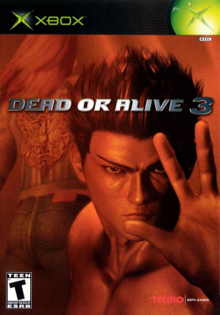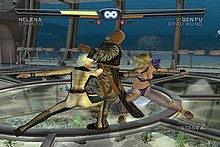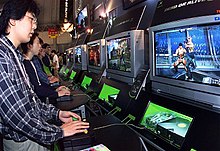Dead or Alive 3
| Dead or Alive 3 | |
|---|---|
 North American cover art featuring Jann Lee (front) and Hitomi (background) | |
| Developer(s) | Team Ninja |
| Publisher(s) | Tecmo Microsoft Game Studios (Europe) |
| Director(s) | Tomonobu Itagaki Hiroaki Matsui |
| Producer(s) | Tomonobu Itagaki Yasushi Maeda |
| Designer(s) | Katsunori Ehara |
| Programmer(s) | Mitsuo Osada Takeshi Sawatari |
| Writer(s) | Hiroaki Matsui |
| Composer(s) | Makoto Hosoi Takashi Inamori Ryo Koike |
| Series | Dead or Alive |
| Platform(s) | Xbox |
| Release | |
| Genre(s) | Fighting |
| Mode(s) | Single-player, multiplayer |
Dead or Alive 3 (Japanese: デッドオアアライブ3, Hepburn: Deddo Oa Araibu Surī, abbreviated as DOA3) is a fighting game in the Dead or Alive series, developed by Team Ninja and published by Tecmo in 2001 exclusively on the Xbox console as one of its launch titles. Dead or Alive 3 improved upon the gameplay and graphics in superior detail compared to that of its predecessors.
The game's story focuses on DOATEC's attempt to create the ultimate human weapon through the Omega project by transforming the Mugen Tenshin Ninja Clan's Hajin Mon leader Genra into the evil superhuman, Omega, and the ninjas entering the third Dead or Alive tournament to defeat him.
Dead or Alive 3 was very well received. It was a commercial success upon release, selling over 1 million copies[1] worldwide in the first five months after its release, becoming one of the top best selling Xbox games.
Gameplay[]

The basic gameplay controls remain essentially unchanged from Dead or Alive 2. Some minor tweaks have been added to the game system in the form of increased counter periods, unrestricted 3D-axis movement, and less emphasis on juggling combos. All these gameplay enhancements make the game a bit suited for beginners, and makes the artificial intelligence a bit more forgiving. Move properties for character attacks are updated. The game incorporated less damage percentiles in counter maneuvers, making players rely more on blows and throws. Fighters who are caught in hazardous falls can now be knocked out if they have very low health.
The game adds a new feature in its Sparring mode called "Exercise", which is a command tutorial in which players can practice learning character moves while commands are displayed at the same time.
The tag team system, introduced in the previous game, was also updated. Tag Battle is made available to select in the game's Time Attack and Survival modes. A new feature called "Attack Change" was added, allowing the character tagging in to attack while switching in. The Tag Throws command was made a bit easier to activate.
As with previous entries in the series, the game takes advantage of the Xbox system's power to push the range of the graphics and stage sizes farther than DOA2. The game has less unlockable content compared to DOA2: Hardcore. By default, the game utilizes the Xbox controller's pressure sensitive analog face buttons to allow shortcuts in performing certain moves, making the controls lenient to allow players new to the series to adapt to gameplay, players have the option to turn the analog buttons on or off.
Characters[]
Dead or Alive 3 features a total of 18 fighters, including 17 playable characters and the boss character Omega. The characters returning from the previous installments are Ayane, Bass Armstrong, Bayman, Ein (unlockable), Gen Fu, Helena Douglas, Jann Lee, Kasumi, Leifang, Leon, Ryu Hayabusa, Tina Armstrong, and Zack. Playable newcomers are Chinese drunken master Brad Wong, British assassin Christie, Japanese ninja Hayate (appeared in the roster of the previous title as "Ein"), and German-Japanese karateka Hitomi.
New[]
- Brad Wong, a Chinese drunken fighter whose teacher Chen sends him on a journey to search for the mysterious wine called "Genra".
- Christie, a British assassin and she quan practitioner hired by Victor Donovan, leader of DOATEC's anti-Douglas faction. She enters the tournament in order to keep an eye on Helena.
- Hayate, a Japanese ninja and the 18th leader of the Mugen Tenshin Clan who appeared in the previous game as "Ein". He enters the tournament again in order to defeat Genra, the superhuman created as a puppet of DOATEC's Project Omega.
- Hitomi, a German-Japanese karateka who joins the tournament in order to test her formidable skills against the real world.
- Omega (unplayable), the evil superhuman of DOATEC's Project Omega who used to be Genra, the leader of the Mugen Tenshin's Hajin Mon sect.
Returning[]
- Ayane
- Bass Armstrong
- Bayman
- Ein (unlockable)
- Gen Fu
- Helena Douglas
- Jann Lee
- Kasumi
- Leifang
- Leon
- Ryu Hayabusa
- Tina Armstrong
- Zack
Plot[]
The hero ninja Ryu Hayabusa put a stop to the evil doings of Tengu, but it was too late to stop him from triggering a massive worldwide collapse. A dense cloud covered the entire planet in a shroud of darkness and fear. DOATEC has gone astray, turning into the hunting grounds for power-hungry scam artists.
This is when DOATEC's development department (a fortress for state-of-the-art military technology) witnesses the success of a genius. Following Project Alpha and Project Epsilon, the ever ambitious scientist, Dr. Victor Donovan completes the Omega Project, producing a new superhuman: Genra. The man, who was once leader of the Hajin Mon ninjas of the Mugen Tenshin Clan, is no longer human, but a force of singular and unprecedented capabilities known as Omega. To test the subject Omega's skills, DOATEC announced the third Dead or Alive World Combat Championship.
The ninjas Hayate, Ayane, and Ryu Hayabusa enter the third tournament to defeat Genra. Bayman, the assassin who was once hired by Victor Donovan to kill Fame Douglas during the first tournament, enters the third tournament to get revenge on Donovan after he sent a mysterious sniper to kill him. Bayman easily disposed the sniper, but the feeble attempt on his life left Bayman in anger and in retaliation against Donovan. Helena Douglas, daughter of Fame Douglas was captured by the anti-Douglas faction of DOATEC led by Donovan. Whether Helena likes it or not, she is dragged into the intertwined conspiracies within the huge DOATEC organization. Donovan challenges Helena to win the third tournament. If she wins, she will regain her freedom and learn the truth behind DOATEC. To prevent her from winning, Donovan hires a British assassin named Christie to keep an eye on her, and kill her if necessary.
Hayabusa is prepared to bring down Genra but Hayate states to Hayabusa that he does not know Genra like he does since he and Genra are from the same clan. Hayate also states that since he is the new leader of the Mugen Tenshin Clan, he should defeat Genra instead. Later, both Ayane and Hayate argue on who should defeat Genra. Ayane, as a Hajin Mon ninja and Genra's foster daughter, feels it is her duty to defeat him and that fate commands her to put Genra out of his misery. Eventually, Hajin Mon's Ayane wins the third DOA tournament and kills Genra.
Development and release[]

After the success of Dead or Alive 2, Tecmo was working on continuing the series when Microsoft approached them, offering a deal to develop the next Dead or Alive as an exclusive title for the recently announced Xbox. The Xbox was still in development, and Microsoft was in need of exclusive, high-profile games to show off the technical capability of their product. This deal also fit in with series creator Tomonobu Itagaki's design philosophy of always targeting the most powerful console available for the development of Dead or Alive games.
In 2001, the release of Dead or Alive 3 was announced in Japan, but the game was first released in the US, in order to coincide with the American Xbox launch. An updated version of Dead or Alive 3 was then released for the Japanese and European Xbox launches several months later.
The European and Japanese versions of Dead or Alive 3 feature more content such as extra costumes, new attacks for characters, and a new cinematic introduction for the game. Because of its early release, the North American version does not feature any of the above. In June 2002, Official Xbox Magazine provided a 'Booster Disc' for DOA3 which included the new cinematic introduction and all of the extra costumes released on the EU and JP versions of the game, but it did not however contain the extra fighting moves or general game balancing tweaks that the other versions brought. The booster content continued to be provided with the Official Xbox Magazine demo disc from June 2002 to September 2002; each disc featured the same content but gave magazine buyers multiple times to acquire it. The Platinum Collection edition of the game was released in 2003.
In addition to the original song in the game, three songs by the American rock band Aerosmith also appear in Dead or Alive 3 and can also be played in the game's Settings option. "Nine Lives" was used as the opening theme, and "Home Tonight" was played over the credits. "Amazing" was not used in the actual game, but was a music sample under the Settings option.
An Arcade Stick for Dead or Alive 3 made by Japanese video game peripheral manufacturer Hori was released exclusively for the Xbox on February 22, 2002 to coincide with Dead or Alive 3 and the Xbox launch in Japan.
A soundtrack CD for the game, titled Dead or Alive 3 Original Sound Trax (KWCD-1006), was released by Wake Up in 2002. A guide book titled Dead or Alive 3: Prima's Official Strategy Guide by Prima Games was published on November 5, 2001. Three more guide books were published in Japan in early 2002: Dead or Alive 3 Guide Book (デッド オア アライブ3 ガイドブック) by Famitsu / Enterbrain, Dead or Alive 3 Kōshiki Kōryaku Guide (デッド オア アライブ3 公式攻略ガイド) by Kodansha, and Dead or Alive 3 Perfect Guide (デッド オア アライブ3 パーフェクトガイド) by SoftBank.[2]
Dead or Alive 3 later became backwards compatible for the Xbox 360.
Reception[]
| Aggregator | Score |
|---|---|
| GameRankings | 86.2%[3] |
| Metacritic | 87/100[4] |
| Publication | Score |
|---|---|
| Famitsu | 37/40[5] |
| Game Informer | 9.25/10[8] 9.5/10[9] |
| GamePro | 5/5[6] |
| GameRevolution | B[7] |
| GameSpot | 7.9/10[10] |
| IGN | 9.4/10[11] |
| OXM (US) | 9.5/10[12] |
| TeamXbox | 8.2/10[13] |
| Gamereactor | 9/10[14] |
| GameShark | 8.9/10[15] |
| Next Generation | |
| Xbox World | 9/10[17] |
| Publication | Award |
|---|---|
| Academy of Interactive Arts & Sciences | Fighting game of the year |
| National Academy of Video Game Trade Reviewers | Game, Franchise Fighting |
| GameSpot Game of the Year | Best Graphics, Technical |
Upon its release, Dead or Alive 3 received very positive reviews. In Japan, Famitsu scored the game a 37 out of 40.[5] IGN stated that it "represents the new standard of excellence that only the Xbox can deliver," praising the game for its great attention to detail and its vast improvements on its predecessor.[11] On the other hand, GameSpot's Greg Kasavin opined that "once you get past its graphics, you'll find that Dead or Alive 3 doesn't offer much of anything that hasn't been done in other 3D fighting games."[10] It won GameSpot's annual "Best Graphics, Technical" prize among console games, but also received a nomination in the "Most Disappointing Game" category.[18]
Dead or Alive 3 was one of the best-selling installments in the series. In 2002, Tecmo announced the game had reached sales of over 1 million copies worldwide in the first five months after its release.[19][20] By July 2006, Dead or Alive 3 had sold 950,000 copies and earned $36 million in the United States alone. Next Generation ranked it as the 59th highest-selling game launched for the PlayStation 2, Xbox or GameCube between January 2000 and July 2006 in that country. Combined sales of Dead or Alive fighting games released in the 2000s reached 1.3 million units in the United States by July 2006.[21] The game became the third best-selling launch title next to Microsoft's Halo: Combat Evolved and Project Gotham Racing and the first third-party Xbox game to garner Platinum status.[citation needed]
In 2008, Cinema Blend ranked it as the eight best fighting game of all time.[22] In 2011, Complex ranked it as the 15th best fighting game of all time.[23] GamesRadar included it among the Xbox games "that shaped the generation,"[24] and later included it in their list of "best original Xbox games."[25]
References[]
- ^ "Dead or Alive 3 reaches 1 million - GameSpot". www.gamespot.com. Retrieved 2019-12-05.
- ^ "Dead or Alive 3". Arcade Gear. Archived from the original on 2014-01-31. Retrieved 2013-12-21.
- ^ "Dead or Alive 3 for Xbox". GameRankings. 2001-11-14. Retrieved 2013-12-21.
- ^ "Dead or Alive 3 for Xbox Reviews". Metacritic. Retrieved 2013-12-21.
- ^ Jump up to: a b Xbox - DEAD OR ALIVE 3. Weekly Famitsu. No.915 Pt.2. Pg.103. 30 June 2006.
- ^ "Dead or Alive 3 Review for Xbox on GamePro.com". 2005-02-07. Archived from the original on February 7, 2005. Retrieved 2016-03-06.
- ^ "Dead or Alive 3 Review". Gamerevolution.com. Retrieved 2013-12-21.
- ^ "Dead or Alive 3". Game Informer: 98. December 2001.
- ^ "GameInformer.com - Review". 2003-10-25. Archived from the original on October 25, 2003. Retrieved 2016-03-06.
- ^ Jump up to: a b "Dead or Alive 3 Review". GameSpot.com. Retrieved 2013-12-18.
- ^ Jump up to: a b "Dead or Alive 3 - Xbox - IGN". Uk.ign.com. 2004-10-18. Retrieved 2013-12-18.
- ^ Official Xbox Magazine, December 2001.
- ^ "Dead or Alive 3 Review (Xbox)". Reviews.teamxbox.com. 2001-11-14. Archived from the original on 2013-12-24. Retrieved 2013-12-21.
- ^ Jonas Mäki. "Dead or Alive 3 Recension - Gamereactor Sverige". Gamereactor.se. Retrieved 2016-03-06.
- ^ "Xbox: Dead or Alive 3 Review". 2001-11-20. Archived from the original on November 20, 2001. Retrieved 2016-03-06.
- ^ Next Generation, January 2002, page 33.
- ^ Xbox World, issue 1 (April 2003), page 122.
- ^ GameSpot VG Staff (February 23, 2002). "GameSpot's Best and Worst Video Games of 2001". GameSpot. Archived from the original on August 3, 2002.
- ^ Giancarlo Varanini (2002). "Dead or Alive reaches 1 million". Gamespot.
- ^ Icons: Dead or Alive (television program).
- ^ Campbell, Colin; Keiser, Joe (July 29, 2006). "The Top 100 Games of the 21st Century". Next Generation. Archived from the original on October 28, 2007.
- ^ "Top 10 Best Fighting Games Of All Time". December 7, 2008. Retrieved April 3, 2013.
- ^ Peter Rubin, The 50 Best Fighting Games of All Time, Complex.com, March 15, 2011
- ^ GamesRadar US (2012-06-23). "The games that shaped a generation: Xbox". GamesRadar. Retrieved 2013-12-21.
- ^ "Best original Xbox games of all time". GamesRadar+. Retrieved 2016-03-13.
External links[]
- Official website (Tecmo)
- Official website (Team Ninja) (in Japanese)
- Dead or Alive 3 at MobyGames
- 2001 video games
- 3D fighting games
- Dead or Alive (franchise) video games
- Interactive Achievement Award winners
- Versus fighting games
- Tag team videogames
- Tecmo games
- Video game sequels
- Video games featuring female protagonists
- Xbox games
- Xbox-only games
- Esports games
- Multiplayer and single-player video games
- Science fiction video games
- Video games with AI-versus-AI modes
- Video games about ninja
- Video games about revenge
- Martial arts video games
- 2000s fighting video games
- Motion capture in video games
- Cancelled Dreamcast games
- Video games developed in Japan
- Video games set in Venezuela
- Video games set in Iceland
- Video games set in Japan
- Video games set in Hong Kong
- Video games set in Germany
- Video games set in the United States
- Video games set on islands
- Video games set in Italy
- Video games set in Australia
- Video games set in Saudi Arabia
- Video games set in China
- Video games set in the 21st century